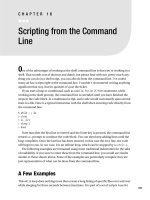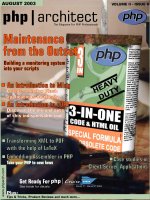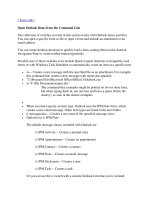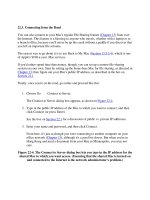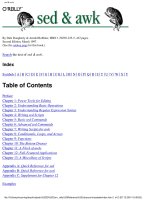Math from the Shell
Bạn đang xem bản rút gọn của tài liệu. Xem và tải ngay bản đầy đủ của tài liệu tại đây (69.3 KB, 5 trang )
75
■ ■ ■
CHAPTER 11
Math from the Shell
M
athematical calculations are an important element of writing shell scripts. In the
various flavors of UNIX, there are multiple ways to perform just about any task, and math-
ematical tasks are no exception.
Although there are many types of mathematical computations, I’ve limited the discus-
sion in this chapter to the basic operations of addition, subtraction, multiplication, and
division, plus remainder, exponentiation, and trigonometric functions. The examples
make use of the variables a, b, c, and d.
One note on division: some programming languages don’t perform integer division
like you might expect from using your traditional calculator. There are two parts to the
quotient of an integer-division problem, the whole (or integer) part and the remainder.
Take the example of 5 divided by 3; the whole part of the quotient is 1 and the remainder
upon division is 2. In some of this chapter’s methods for doing math in the shell, there are
two distinct operators for integer division. The slash (/) operator returns the whole part
and the percent (%) operator returns the remainder. Keep this in mind when performing
your calculations.
expr
This chapter’s first math method is the use of expr. expr is a utility that evaluates
various types of expressions, including ones containing string, logical, and mathe-
matical functions. The following are examples of how to use expr to carry out
mathematical operations:
Addition: answer=`expr $c + $d`
Subtraction: answer=`expr $c - $d`
Multiplication: answer=`expr $c \* $d`
Division: answer=`expr $c / $d`
Remainder: answer=`expr $c % $d`
There are no explicit trigonometric or exponentiation functions in expr.
76
CHAPTER 11
■
MATH FROM THE SHELL
There are a couple of items to keep in mind when using expr. As shown in the exam-
ples, single spaces are required between the expr call and its arguments, and between the
operators and their arguments. Also, when using the asterisk (*) character for multiplica-
tion, the shell will interpret it as a wild card and expand it to the elements in your current
directory before attempting to evaluate the expression unless you either escape the aster-
isk via \* or turn off globbing
1
(path and file expansion) using set -f.
Internal Shell Math
The shell itself can perform mathematical operations. The advantage of using the internal
math functions is that your code doesn’t have to call an external program, which reduces
the footprint of the code and allows it to run faster. This method is available in bash and
ksh. The Bourne shell does not have this functionality. The following are examples of how
to employ internal shell math to carry out mathematical operations.
■
Note
The largest integer available for internal shell math is 2
63
–1, or 9,223,372,036,854,775,807 (in
bash and expr; ksh uses scientific notation for large numbers). This is the maximum 64-bit integer. If you
need numbers that are larger than this, you must use the bc or dc calculator.
Addition: answer=$(($c+$d))
Subtraction: answer=$(($c-$d))
Multiplication: answer=$(($c*$d))
Division: answer=$(($c/$d))
Remainder: answer=$(($c%$d))
Exponentiation: The first argument raised to the power of the second;
answer=$(($c**$d))
Order of operations: The default order can be modified by using parentheses, as with
the other methods of performing shell math; answer=$((($c+$d)*$c)). Without the use
of parentheses to order the calculations as you desire, the common order is as follows:
1.
Perform any calculations surrounded by parentheses. These are ones that you
may not have specified.
1. Globbing is the term used for the shell’s completion of paths and filenames that contain
metacharacters.
CHAPTER 11
■
MATH FROM THE SHELL
77
2.
Perform all calculations that are exponents or roots, such as a square or
cube root.
3.
Working from left to right, perform any multiplication or division.
4.
Working from left to right, perform any addition or subtraction.
A math library available in ksh lets us perform more-sophisticated mathematical calcu-
lations. These are the functions it provides: abs(), acos(), asin(), atan(), atan2(), cos(),
cosh(), exp(), floor(), fmod(), hypot(), int(), log(), pow(), sin(), sinh(), sqrt(), tan(),
and tanh(). Table 11-1 gives a basic description of these functions, but their use is beyond
the scope of this book. The following variable assignment demonstrates the use of one of
these higher level mathematical functions:
answer=$((cos($a)))
Table 11-1. Descriptions of Trigonometric Functions Available in
ksh
Trigonometric
Function Description
abs() Absolute value
acos() Inverse cosine
asin() Inverse sine
atan() Inverse tangent
atan2() Four-quadrant inverse tangent
cos() Cosine
cosh() Hyperbolic cosine
exp() Exponential
floor() Round toward negative infinity
fmod() Floating-point remainder of division
hypot() Square-root of sum of squares
int() Integer portion of a real number
log() Natural logarithm
pow() Raise base number to an exponential power
sin() Sine
sinh() Hyperbolic sine
sqrt() Square root
tan() Tangent
tanh() Hyperbolic tangent
78
CHAPTER 11
■
MATH FROM THE SHELL
bc
The bc utility is an arbitrary-precision calculator. This means the precision of the answer
can be set at runtime through the use of the scale operator. Most of the mathematical shell
utilities described up to this point focus on operations on whole numbers. The exception
is the special library of functions available in ksh. With bc, you can set the scale (number
of decimal places following the decimal point) so that results will be expressed as floating-
point numbers of the precision you specify. The functional use of bc is very similar to the
use of expr, as the following list shows:
Addition: answer=`echo "$c+$d" | bc`
Subtraction: answer=`echo "$c-$d" | bc`
Multiplication: answer=`echo "$c*$d" | bc`
Division: answer=`echo "$c/$d" | bc`
Remainder: answer=`echo "$c%$d" | bc`
Exponentiation: answer=`echo "$c^$d" | bc`
Scale: The scale of a floating-point number is the number of digits that follow the
decimal point. To set the scale when performing a calculation, you use answer=`echo
"scale=5;$c/$d" | bc`.
Trigonometric functions: To use the trigonometric functions, you must enable the
math library by invoking bc using the -l switch. When the library is enabled, the default
scale is set to 20 decimal places. The following examples set the scale to 5 places:
• Sine in radians: answer=`echo "scale=5;s($a)" | bc -l`
• Cosine in radians: answer=`echo "scale=5;c($a)" | bc -l`
• Arctangent in radians: answer=`echo "scale=5;s($a)" | bc -l`
dc
The dc utility is another arbitrary-precision calculator, and it works much like bc. Its main
distinction lies in its use of reverse Polish notation.
2
dc uses a stack to store numbers; eval-
uating a number pushes it onto the stack, and the operations pop their arguments off the
stack and push the result back onto the stack. For shell scripting purposes, I have not used
2. More information on reverse Polish notation (RPN) can be found at />Reverse_polish_notation.
CHAPTER 11
■
MATH FROM THE SHELL
79
the dc calculator. It is a valuable program, but the majority of the calculations I’ve needed
are fairly simple and don’t require the advantages it provides. I mention it only for the
sake of completeness.


